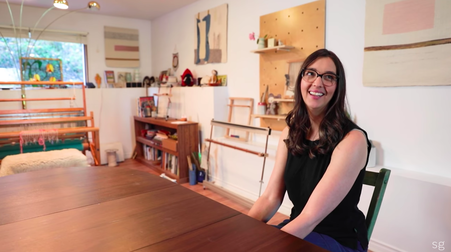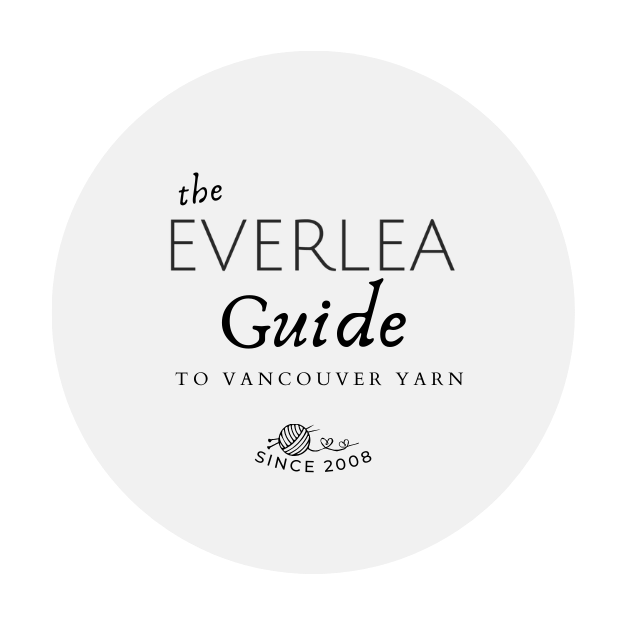|
12/23/2015 The Tapestry Unlimited Blog Tour begins!Welcome to the first post in American Tapestry Alliance's Tapestry Unlimited Blog Tour! I'm starting you off with the basics of tapestry weaving/weft-faced weaving. There are a few different ways to approach beginner tapestry weaving, so after humming hawing I decided I'd teach you more-or-less the way I was taught in textile art school. I'm even using the kind of loom we worked on, but I made it in PVC instead of the copper ones we used so you would know about the most affordable option. I have posted the DIY PVC Loom video here, and in this post are two videos: 1) The easiest way to warp up this loom (above), to be woven in an open-shed style. To follow along with this project you will need
2) A beginner weaving tutorial (below). To follow along with this video you will need
I hope the videos are clear and easy to follow, and please feel free to comment with any questions orjoin the Vancouver Yarn Ravelry group and participate in the Tapestry Unlimited Blog Tour thread where we can chat about this post as well as the other ladies' tutorials coming up. If you're weaving along with us we'd love to chat there about your weaving adventures. Also, if you're posting pictures or videos you can use the hashtag #tapestryunlimited so we can find each others' posts.
The loom I am using in these videos is a PVC version of Archie Brennan's copper loom, which admittedly is much sexier and more sturdy than PVC. Copper will take as much tension as you want to give it, whereas this PVC might bow a bit if you crank the heck out of your warp tension control. There are other DIY pipe looms that have bells and whistles over at Archie Brennan's website too, as well as a PVC version over at Sarah Swett's blog. There are a number of ways to warp up any given portable tapestry loom; the most frequently used (as far as I know) is the one that Mirrix illustrates in this video which allows you to rotate your tapestry to the back of your loom as you work to allow you to get more length out of your warp, like this. Today I shared a simple method that does not feature that, but you won't need it to have fun trying your hand at weaving, and if you like it you'll have a good foundation to inform the way you understand the looms and methods that offer bells and whistles.
I haven't forgotten about the prizes! Every week you have have a chance to enter to win one of two prizes 1) a one-year membership to American Tapestry Alliance , and 2) a one-year membership to American Tapestry Alliance as well as a free entry to the exhibition this blog tour is celebrating, Tapestry Unlimited:11th International, Unjuried Small Format Exhibition. Today you will have the opportunity to increase your chances of winning by twenty-five times by sharing this post on social media and other methods using the widget below. Current ATA members are not eligible to win. Scroll down for a glossary and other ramblings that accompany the videos as well as some resources and links, many of which were complied from fellow blog tour instructors' blogs regarding suggestions for warp, weft and EPI considerations.
The Blog Tour Line-Up
December 23rd: Vancouver Yarn: The basics: warping up and weaving open-shed style December 30th: Rebecca Mezoff: Using irregular hatching to blend color January 6th: Terry Olson: Weaving slits to create vertical lines January 13th: Mirrix Looms: Weaving shapes: Triangles, Squares and Circles January 20th: Elizabeth Buckley: Using multiple wefts to blend color January 27th: Sarah Swett: The value of Tapestry
Thank you so much for stopping by! I hope you follow the upcoming weekly posts by our amazing lineup of tapestry teachers. Rebecca Mezoff is next week with a technique called irregular hatching, which is a fancy term for one of the ways to approach color blending. Scroll down and press 'read more' for the glossary and resources that accompany this post as well as more about the Tapestry Unlimited exhibition.
American Tapestry Alliance is a nonprofit organization that provides programming for tapestry weavers around the world, including exhibitions (like Tapestry Unlimited), both juried and unjuried, in museums, art centers and online, along with exhibition catalogues. They offer workshops, lectures, one-on-one mentoring and online educational articles as well as awards, including scholarships, membership grants, an international student award, and the Award of Excellence. They also put out a quarterly newsletter, monthly eNews & eKudos and CODA, an annual digest. Members benefit from personalized artists pages on the ATA website, online exhibitions, educational articles, access to scholarships and more.
This blog tour is in celebration of ATA's annual unjuried exhibtion. Tapestry Unlimited; 11th International, Unjuried Small Format exhibition is open to all weavers. We are expecting upwards of 250 participants who will show their work at the Milwaukee Public Library this upcoming summer. Everyone who signs up to participate by January 31st 2016 will be included in the exhibition, and your tapestry does not need to be mailed to us until March 2016. There is an exhibition fee of $40 which pays for both the return postage for you tapestry as well an exhibition catalogue, which everyone’s tapestry will be featured in. We invite entries which work within more traditional definitions of tapestry as well as ones which expand upon them, including multimedia work.
Tapestry Unlimited hangs at the Milwaukee Public Library from July 26 – August 11, 2016 Glossary & Resources:
Warp: The yarn that is wrapped around the loom under tension
Shed: The space between the front and back working warp yarn. Weft: The yarn that is passed between the shed to be woven. This yarn completely covers the warp yarn. Open-shed and open-shed style vs other tapestry weaving styles: Open shed is a bonafide term, but I'm not sure if I heard it else-wear or if I'm making up it up, but I'm calling the style of warping up and weaving 'open shed style' because after you've warped up your loom the resting state of your loom has an open shed. That means there is a space between the front and back portions of your working warp. There are other types of tapestry weaving where you will see the weaver working with only the front warps on the loom. They may create sheds by going over and under the warps using a threaded needle or by finger picking and using a baton for the other shed, and then there are shedding devices which open both sheds using heddles and handles or other devices. I like the method I show as a beginner method for three reasons, 1) Warping up is simple 2) The open shed is easy to understand and use 3) Finger picking is a good skill to have and manipulating the threads manually helps you understand the structure of tapestry. EPI: Stands for 'ends per inch' and refers to how many warp threads are found in a one inch wide area on your dressed loom. How to decide on your EPI: In these videos I make it easy by suggesting that beginners warp up at 6 EPI and use worsted weight yarn or the equivalent made up of multiple strands. In her blog post Claudia from Mirrix Looms explains making EPI decisions like this, "Unfortunately there is not a simple trick for figuring out your warp spacing. Every weft and warp combination is different and it might take some time to begin to get a sense of what warp coil should be used each time you weave a new piece. A good way to determine if your [EPI] is correct is to put your weft in between your warp threads vertically when your loom is warped. If your weft threads are much thicker than the space between the two warp threads, then your weft is probably too thick and if your weft threads are much thinner than you know your weft is too thin."
Alternatively, If you know what yarn you want to use for warp and weft but are not sure what EPI to set your loom up with you can hold together the two strands of yarn in one hand (one weft and one warp) and wrap them around a ruler so they are alternating each other and sitting directly next to each other. Wrap them over one inch and then count only the warp threads. The number of warp thread in that inch will be your EPI (see pic below). Rebecca Mezoff recently shared this great post on her blog sharing different results based on varying weft, warp and EPI combinations.
Weft Bundle/Butterfly: in tapestry weaving there are a number of ways to carry your weft thread. Some people use bobbins while others use weft butterfies. Click here to learn how to make a weft butterfly.
Weft yarn options: For this video I am using Custom Woolen Mills' 3ply mule spinner yarn, the blue I've hand-dyed in indigo. Here is a blog post by Rebecca Mezoff about other weft yarn options. Read the comments in her post for others' suggestions, too. Square Knot: A square knot is that knot that everyone knows how to do, it involves the first move you teach a kid when they are learning to tie their shoes the bunny ears way. Is that a funny explanation? Here's a video (it's hilariously slow, sorry I couldn't find a better one). A double square knot is that same knot repeated for reinforcement. Double Half Hitch Knot: This knot allows you to tighten or loosen the last warp you wrapped when you've finished warping your loom. Rebecca Mezoff has a great video here illustrating how to make one and how it works. 12/23/2015 01:33:53 pm
Thank you for the videos. I am a self taught weaver,but always look for more information from other weavers. 12/23/2015 04:27:16 pm
You're so welcome! Glad you're already learning something different from how you work.
Joy P Duskin
12/23/2015 06:39:26 pm
That was a fun beginning...Thank you
Janna
12/23/2015 06:50:51 pm
I'm glad you thought so, thanks!
Mary Moore
12/23/2015 06:47:56 pm
The timing of The Tapestry Unlimited Blog Tour is perfect for me. The Tapestry Study Group within my weaving and spinning guild will begin a series of tapestry seminars for new and beginning tapestry weavers. I will be a participant and the Blog Tour will provide additional valuable information.
Janna Maria Vallee
12/23/2015 06:52:01 pm
Great timing! So glad it be helpful along the way. 12/24/2015 06:06:57 am
Thank you for sharing the tutorial on how to make the loom with pvc pipe. 12/24/2015 07:56:38 am
Very clear instructions for beginners! Great job. Sharing with my guild.
Bonnie
12/24/2015 10:14:44 am
Love your video format.
Suzanne
12/24/2015 04:26:43 pm
FYI. I use Firefox and the font used on this blog uses something that doesn't look like the letter "t" for all the t's. Some other letters are weird as well. I tried it in Internet Explorer and it looks ok. Means somebody only tested IE and not Firefox. It will be awfully hard for a beginner to follow with undecipherable words.
Janna
12/24/2015 08:57:59 pm
Thanks for letting me know, I'll look into that right away. 12/24/2015 08:13:24 pm
I love the idea behind the blog tour. I took a couple of classes with Elizabeth, as well as classes here in San Antonio at the Southwest School of Art, and will use the tour to get back to that naked warp on one of my looms.
Janna
12/28/2015 07:08:50 am
Hi Elysse, so glad you're enjoying it! I'm hoping to get it done by the end of this week. Xo
Joyce marlow
12/28/2015 09:56:21 am
Thanks for all the videos and information. The tour is such a good idea!
Kim Carey
12/28/2015 05:18:33 pm
Thanks, I can't wait to build a loom and get started.
Sue Schwarz
12/28/2015 05:35:10 pm
What a wonderful information filled blog.
Sue Leatherman
12/28/2015 08:43:44 pm
I am a relative newbie to tapestry weaving. I love the creative challenges. I'm excited to see the Tapestry Unlimited Blog Tour because I follow several of the artists on their blog sites so this will be an extra treat! I had seen an article about the Unjuried Small Format Exhibition and thought about submitting and this Blog has helped me to take up the challenge and submit a piece. Thanks for the blog challenge!
Donald Sandoval
12/29/2015 01:01:35 pm
Great post! I have been wanting to make a portable loom and your video was fantastic. I also loved the glossary. Though I have been weaving for years (self taught), I am not very familiar with the vocabulary. Thanks for this tour!
Stevie Van Housrn
12/29/2015 02:10:25 pm
Looking forward to this tapestry journey. Thanks for sharing your knowledge and skills
Janna
12/31/2015 04:56:42 pm
you're welcome, Stevie! Thanks for following! 2/9/2016 01:50:01 am
Great Post!!! 3/18/2016 11:13:28 pm
Hi,
Janna Vallee
2/24/2017 12:37:21 am
Good point! I never thought of it having that function until now. 5/4/2016 02:15:33 am
Very good Blog!!! Thank you for the videos.. I also want to share some beautiful cotton hippie mandala tapestries. Please have a look @ http://www.fairdecor.com/-queen-mandala-tapestry-throw thank you. 9/7/2016 03:51:29 am
Great post. thanks for sharing this wonderful wall tapestry blog. 9/16/2016 04:13:48 am
Thanks for awesome post . i am using tapestry more than 20 years . nice stuff in your blog and great creativity innovation thanks for sharing !!
alina
10/3/2016 03:02:45 am
nice post . thanks for sharing with us. I also want to share some wonderful collection of wall tapestry with you. visit here:- http://www.handicrunch.com/en/wall-hangings-and-tapestry/tree-of-life-tapestry1.html 2/8/2017 12:17:44 am
Good Job! Video is too good | Thanks for sharing article and visit to our website see below link. Comments are closed.
|
The Everlea Guide to Vancouver Yarn is
|
Subscribe to the Guide to Everlea Yarn newsletter!
Vancouver Yarn is a free resource which links you to local DIY textile shops and designers as well as artists and makers which are local to greater Vancouver BC, unceded Coast Salish territory, and throughout so-called British Columbia. I also list online shops and designers from around the country.
Many of my links come from your submissions - Thank you! If you tell me about a dyer, designer, shop etc I will add it.
Many of my links come from your submissions - Thank you! If you tell me about a dyer, designer, shop etc I will add it.
© Everlea Yarn 2023




 RSS Feed
RSS Feed
